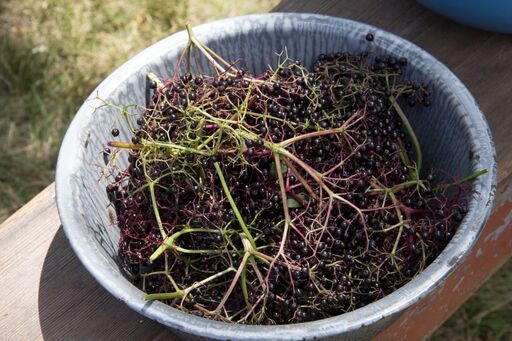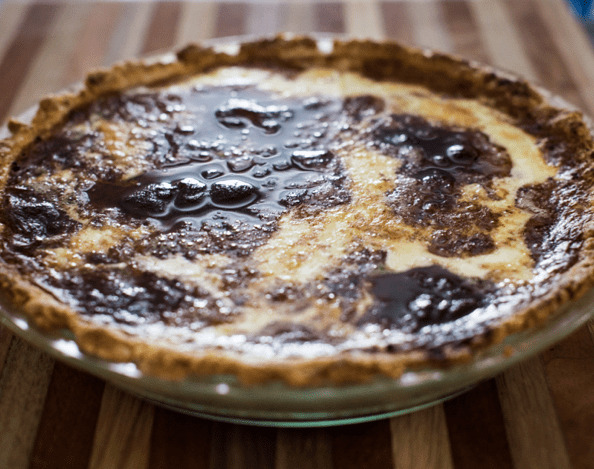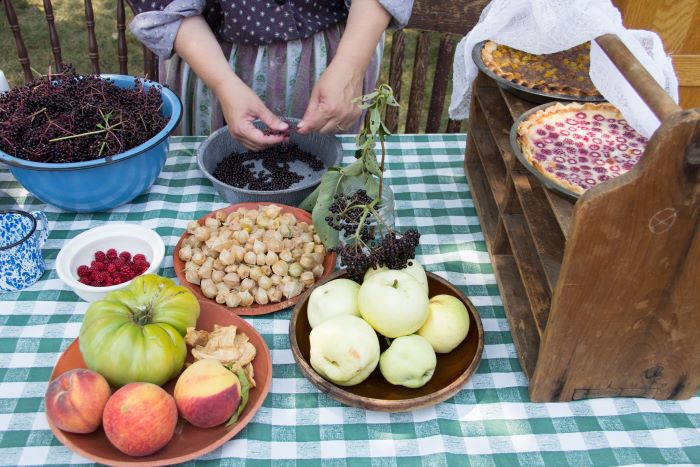By Alice Wolfgang.
Pie was, and still is, an important part of PA Dutch life and there is much to say about pies. Today we’ll take a look at some of the vast variety of pies, some familiar and some more unusual, that were developed in this region. Pies originated in Europe and the English are credited with bringing them to the New World. Pie was not a German tradition as we Pennsylvania Germans like to believe. But when our ancestors learned how to make pie from our English neighbors, they really ran with it. My understanding is that there is not even a dialect word for pie, so “boi” or “pei” is just a Dutchified English word.
According to Goschenhoppen food historian Nancy Roan, the earliest pies were baked in a shallow, redware dish and were simply a layer of bread dough topped with a single layer of fruit. No deep dish nor as sweet as what we have today. Pies would be baked in a bake oven about once/week and then carried either to a springhouse or to the cellar to be kept cooler. To be kept out of the reach of rodents, they’d be placed in a hanging shelf suspended from the ceiling or a pie safe with punched tin doors/sides for ventilation.
Many pies required
Since pie was eaten three times a day and families could be quite large, quite a lot of pies were required. Nancy told me a story of a Mrs. Sadie Kriebel of Hereford, Berks County. Her mother baked pies in an outdoor bake oven. “Reasoning that this must have been in the late 1800s, I asked her if they didn’t have a cook stove and why her mother didn’t use it for baking, she replied, ‘Oh my goodness, you couldn’t get them all in at the stove.’ The bake oven could hold anywhere from 20-24 pies in one baking, with one firing, so it was considered a practical way to bake.”
From the diary of Henry K. Landis in 1935:
After firing the oven for 2 hours or more, Mama could tell if the temperature was just right by the glow of the bricks. She quickly raked out the embers, wiped the oven floor with her swab, and tested the oven by sticking her arm in and counting to 10. If she could do so without having to withdraw her arm, it was perfect for her bread. Others tested the heat of the oven by throwing flour on the oven floor. If light brown, it was ready. Black or burning flour meant it was too hot and needed to cool a bit. Mama needed to work quickly to place the bread in the oven before it cooled…. After the bread was baked, many fruit and custard pies went in. Last of all, a sponge cake or two was baked for Pop or Grandpop.
Although the earliest pies were as described, by the late 19th century, pies were given a second crust. All pies had a top crust with the exception of custards, so bakers developed different markings to indicate the filling. One would not want to set out six raspberry pies, for example, on the table. Not only plain pastry was used. Sweet dough strips were/are sometimes used. Sweet dough is similar to an AP cake dough and adds a bit more sweetness to the pie, so often used on an elderberry (micka kepp or “fly’s head”), a lemon, or schnitz (dried apple) pie. Crumb toppings are popular today and certainly easier than a strip or lattice-crust, but were not found in this region until the 20th century. It was said a young girl was not ready for marriage until she could roll a perfect circle of pie crust!

Pie varieties
Raisin pie was known as “funeral pie”, given that name as it was so often served at a funeral meal. Sweet dough is hardly necessary as raisin pie is quite sweet enough on its own, but is still delicious. Funeral pies were originally made with dried cherries as all households would have a supply of the dried cherries, but once raisins were readily available at the country store, they were used as well.
Before 1850, fruit was either fresh or dried. One could have fresh pumpkins and apples up until around Christmas time, when you’d switch over to dried fruit. Drying was economical…could be done in the sun and air or placed in the bake oven at the end of the baking cycle (18th century). The wood cookstove was a 19th century invention and one could dry vegetables on top of the stove in a large drier. Fruit could be dried on a tray beneath the stove. The mason jar/canning did not become widely available until the latter part of the 19th century. Interesting side note: “In the 1870’s, a jar cost 13 cents” (Nancy Roan). That was a significant cost. Schnitz were dried, peeled apples that were less sweet. The sweeter varieties of apples had the peel left on them and were dried to use in “schnitz ‘n knepp [apples and dumplings]”.
Lemon was a popular flavor, but possibly more appropriate after 1850. Many, many lemon pie recipes abound from the 19th century and we’ve tried quite a few of them at the Goschenhoppen Folk Festival. Sarah Heffner makes her lemon strip every year and Laura Keppley always makes a lemon sponge or crumb. Once we even tried a lemon meringue and had a poor apprentice using a simple wooden tool to beat up the egg whites for about an hour with a certain amount of success. We should have taken a picture of that pie since we’ll probably never do it again.
Custards came in many varieties and flavors. Just a few peaches could be stretched by making them into a custard pie. Or a few berries…raspberries, blackberries, blueberries, mulberries, wineberries, gooseberries, currants….

Thrifty pies
In studying pies from this region, one is reminded of our ancestors’ thriftiness. Pie could be made from almost anything edible. Even some things not considered edible, like green tomatoes, could be used. At the end of the growing season when frost was imminent, the green tomatoes still on the vine could be picked and stored for some time yet as the weather grew colder. A green tomato pie tastes vaguely like an apple pie since cinnamon and nutmeg, along with lots of brown sugar, is added.
And sour milk, which probably was readily available before refrigeration, could be used to make cottage cheese. If you heat the sour milk till it feels hot to your finger and then add some lemon juice, or vinegar, it will curdle. Pour it into cheesecloth and allow to drain and you will have the curds to use in cottage cheese custards. And the whey that drained out could be saved in a bucket and given to the pigs. The curds make a lovely and tangy custard, especially if served with a dollop of molasses for a tart/sweet contrast.
Ground cherry, pumpkin, and mincemeat
Another more unusual fruit is the ground cherry. Ground cherries are a garden plant that bears small yellow fruit that falls to the ground when ripe, which we assume is the reason for the name. We have not been able to find out the source of the PA Dutch name “yudda kasha” for this fruit, although Nancy Roan speculated that the Jewish faith was considered a “false” faith much like this fruit is not really a cherry. We grew up referring to it as a “chew cherry” and did not realize till many years later that this was a Dutchy pronunciation of the English translation of “yudda”. PA Dutch life sometimes included racist ideas and jokes that we children did not understand. But we knew that ground cherry pies are tasty and popular!

The pumpkin pie that we know today would more aptly be called a pumpkin custard. Traditionally, a pumpkin pie was made with sliced and peeled raw pumpkin (or butternut squash), sugar, and spices enclosed within the two crusts.
Mincemeat pie is a good example of the English influence/tradition of pie-making. In a 1971 interview with Hanna Clemens of Lansdale, Abe Roan had a chance to ask about the traditions in her family. One comment she made was that green tomato pie “taste about as good as ground cherry pie”. And then she started talking about mince pie. She said her mother would use three times as many apples as meat. “Too much meat spoils them.” When asked about using beef and/or pork, she said her mother just used beef, but Grandmom Clemens used pork sometimes. And her mother made wine from rose petals for her mincemeat. Here is what she related, “They were big bushes and they were very full of flowers and then she’d go out and gather, in the morning, she’d take a crock and she’d just brush the petals in a crock and then put water on them and leave stand I don’t know how long. Then she’d put sugar in, and it was very sweet, you know. Then she’d put that in the mince pie.”
Shoofly and cake pies
I’ve said nothing so far about probably the most well-known PA Dutch pie, that being the shoofly pie. It can be made in pie form, in cake form, and in bread form. It sometimes is called a molasses crumb cake, even when a pie. Sometimes it is just called shoofly. Regardless, a “wet bottom” of gooey molasses at the bottom of the crust is generally preferred. There are various stories behind the name “shoofly”, the simplest being that the sweetness of it attracts the flies when cooling on the kitchen window sill. Here’s my favorite: it is a corruption of the French choufleur, which means cauliflower, since the texture of its crumb surface resembles a head of cauliflower???
Shoofly is not the only pie that is really a cake. There is also funny cake which is a chocolate layer in the bottom of the crust and topped with a yellow cake batter. Some, well, one person, has been known to even make it with Nutella. And then there is Montgomery pie, similar to funny cake, but with a lemon sauce.

Slop pie
Slop or milich [milk] pie is the last pie made on baking day. Oftentimes, it would be made by a child and I’m happy to say that I got to do this as a child. The remnants of the pie crust were pressed into a dish and then a spoonful of flour, a spoonful of brown sugar, and a bit of cinnamon was mixed together right in the crust. Add a pat of butter and fill it up with milk and bake. It’s a wonderful concoction, sometimes “sloppier” than others, but always good.

Recipes
Traditional Pennsylvania Dutch Pie Crust (Edna Eby Heller)
1 ½ c. flour
½ c. lard
½ tsp salt
3 or 4 T of cold water
Combine flour and salt in mixing bowl. Mix is lard with pastry blender or fingers. Sprinkle on the cold water and mix lightly with a fork or fingers.
Shape dough with hands into a ball and roll on a lightly floured surface with a floured rolling pin. Roll dough lightly from center to edge in all directions to make a circle. Pastry should be about 1/8 ” thick. Fold in half or quarters to move into pan. Fit into pie dish without stretching. Crimp the edges. May reroll if necessary, but overworking the dough tends to toughen it.
Ricotta Cheese Pie Crust (Alice Wolfgang)
This is not a traditional Pennsylvania Dutch recipe but too good not to include.
½ c. ricotta cheese
1/3 c. butter
1 ¼ c. flour
Melt butter. Stir in ricotta cheese. Gently stir in flour and roll out with additional flour as necessary. Makes 1 9″ crust.
Shoofly (Alice Wolfgang)
1 ½ c. flour
½ c. brown sugar
¼ c. butter
Crumble together with pastry blender or fingers.
¾ c. boiling water
¾ c. molasses
¾ tsp baking soda
Stir boiling water and molasses together. (If you spray the cup before measuring the molasses, it empties more easily.) Add the baking soda. Pour the liquid into the pie crust. Sprinkle crumbs on the top.
Bake at 350 for 35-40 minutes.
Apple Crumb Pie (Mennonite Community Cookbook)
6 tart apples (yellow transparent, if you can!)
1 c. sugar
1/3 c. butter
¾ c. flour
1 tsp. Cinnamon
Pastry for one 9″ pie
Pare apples and cut into eighths. Mix ½ c. sugar and cinnamon together and sprinkle over apples. Put apples into unbaked pastry shell.
Combine remaining sugar and flour. Add butter and rub together until crumbs are formed. Sprinkle over apples.
Bake at 425 degrees for 10 minutes and then reduce temp to 350 and bake 35 minutes longer. Great with Longacres’ vanilla ice cream.
Sour Cream Peach Pie (Mennonite Community Cookbook)
4 or 5 peaches
1 c. sugar (can be cut to ½ c so you can eat a bigger piece)
2 eggs
1 c. sour cream (yogurt can be substituted)
Pastry for 1 pie, preferably the ricotta cheese crust
Peel peaches and place halves tightly together, with cut sides up, in the crust. Beat eggs, add sugar and sour cream and pour over the peaches. Bake at 375 degrees for 50 minutes or until center looks set.
Wonderful at room temp, when warm, and when chilled, in other words, anytime.

Author Alice Wolfgang has led the pie baking demonstration at the Goschenhoppen Folk Festival for many years and bakes for the Goschenhoppen December Christmas Market. During this pandemic, she has been known to hang freshly baked goods on someone’s door knob, ring the bell and quickly leave.
Sources
Boyertown Area Historical Society. Boyertown Cookery, 1978.
Clarkson, Janet. Pie, A Global History, 2009.
Cosman, Madeleine Pelner, Fabulous Feasts: Medieval Cookery and Ceremony, 1976.
Heller, Edna Eby Heller, The Art of Pennsylvania Dutch Cooking,1968.
Landis Valley Museum, Pennsylvania German Foods & Traditions, 1999.
Roan, Nancy Hasson,“Ei, Ei, Ei! Pei!“. Goschenhoppen Historians.
Roan, Donald. Interview with Hanna Clemens, Montgomery County, 1971.
Showalter, Mary Emma, Mennonite Community Cookbook, 1950.
William Woys Weaver, Dutch Treats: Heirloom Recipes for Farmhouse Kitchens, 2016.


PIE and ALICE – synonymous! So fun to read this. There is a nice supply of rhubarb in the garden and now a real appetite for a PIE!
LikeLike
Thank you for this wonderful article. I’ve always loved pies, whether fruit, custard, mincemeat or shoo fly. I guess it’s in my genes! I’m thrilled to have the recipe for milk pie which my German grandmother made.
LikeLike
I really love this blog and I am so enjoying it. I realize you can’t include every pie imaginable, but I would loved to have seen some “depression era” pies included. For instance my Grandfather Kriebel, a Schwenksfelder descendant would often make potato pie. Boiled potatoes, with butter and parsley in a double crust served with with warmed milk overtop. I’m not really sure of its origins, or if it even has an origin, other than the Great Depression. But, he and my Grandmother always said it was a “recipe” from the depression era.
LikeLike
Potato pie and corn pie and onion pie are all EXCELLENT main dish pies from our heritage! Simple, inexpensive, and filling. Our family used thinly-sliced raw potato for potato pie. The only other ingredients would be salt and pepper. Double crust, of course! And many people like hot milk poured over the baked pie. Not for me, but then that’s how we get so many wonderful variations. The 1963 Schwenkfelder cookbook has recipes for corn pie and onion pie, but I am not seeing one for potato.
LikeLike
Corn pie and onion pie . . . YUM. You mentioned 1963 Schwenksfelder Cookbook, is it possible to purchase a copy? Have there been other cookbooks over the years? Might copies of those be purchased?
LikeLike
There is always a book stand at the Goschenhoppen Folk Festival with many wonderful titles and both the Schwenkfelder Library and the Mennonite Heritage Center have gift shops/bookstores. I’m pretty sure that the Schwenkfelder Cookbook is still in print!
LikeLike
this makes me hungry for some pie. the interviews with others form years ago were interesting to me.
LikeLike
So Many types of pies its incredible!
LikeLike
It’s really interesting to see how much pie was made in the past. It makes me hungry!
LikeLike
It’s really interesting how you choose the topic pies for your blog.
LikeLike
I love how for your slop pie you said how you made it when you were a kid. I think that it is important to share your experiences when you are talking about something, it helps hook the reader and helps the reader to connect to you.
LikeLike
I like how you included the interviews from people before. Also, all of the pies sound delicious. hope this pandemic is over soon so there will be a Goschenhoppen festival.
LikeLike
I read this article and it reminded me of the strawberry pie at the Country Fair & Auction. We tried making it at home and it worked.
LikeLike
My mom makes a lot of these kinds of pies. Some of my favorites are funny cake, potato pie, shoo fly pie, and whoopie pies.
LikeLike
Thanks for sharing Alice.
LikeLike
Why did you right about Pie? Which pie is your favorite?
LikeLike
These pies look really delicious. If I have not eaten pies, it will be very very regret.
LikeLike